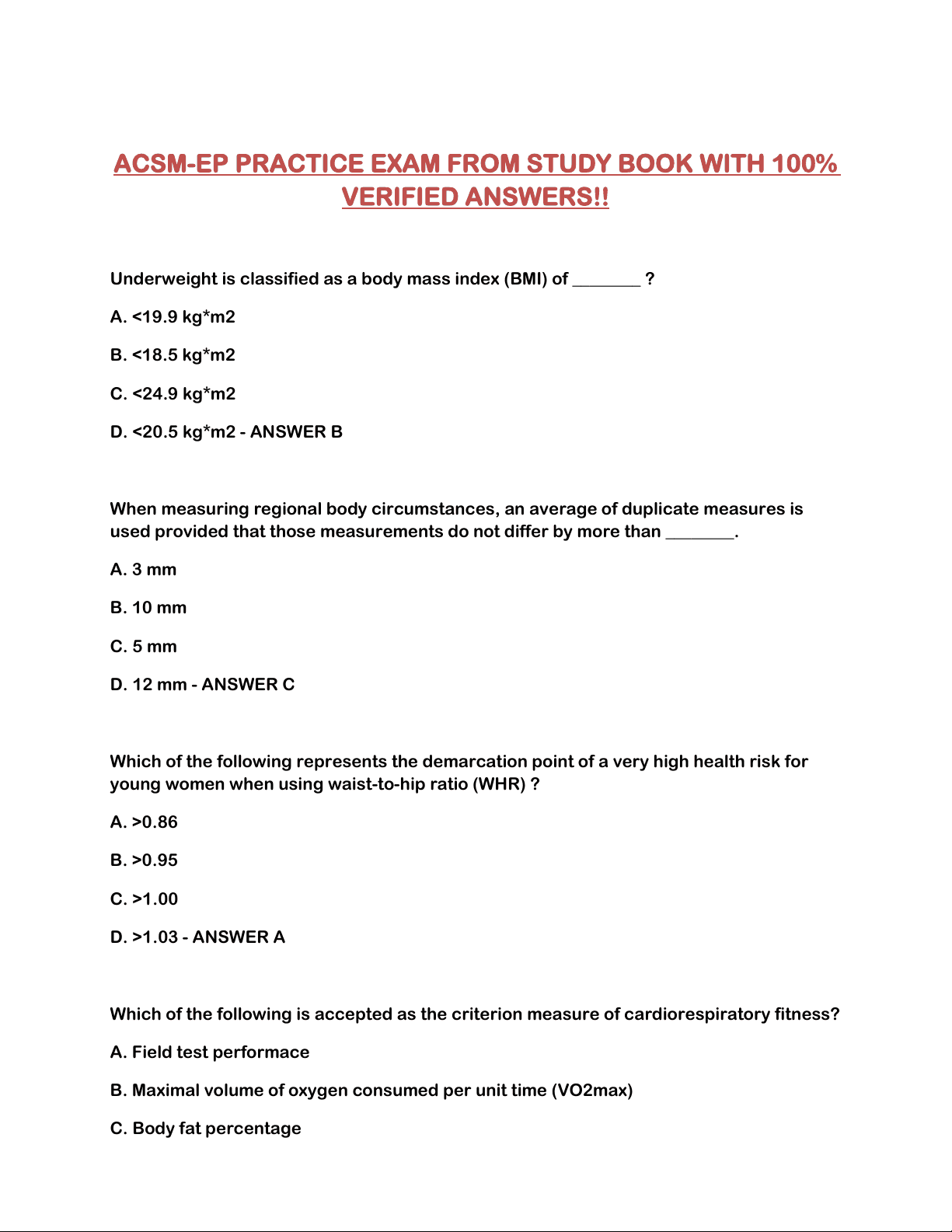

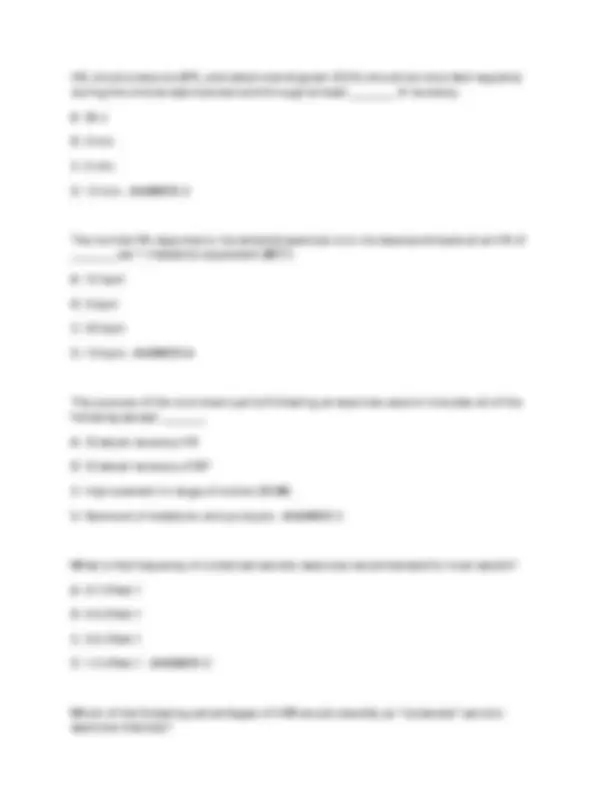
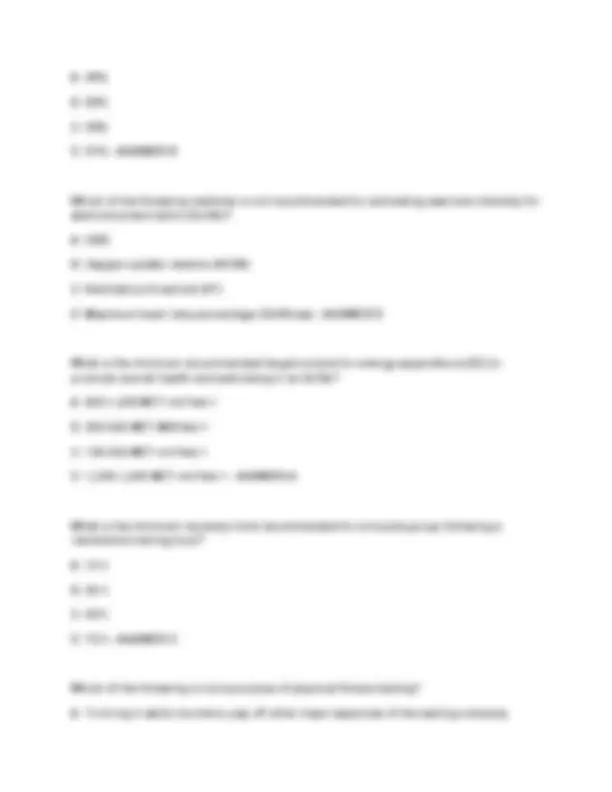
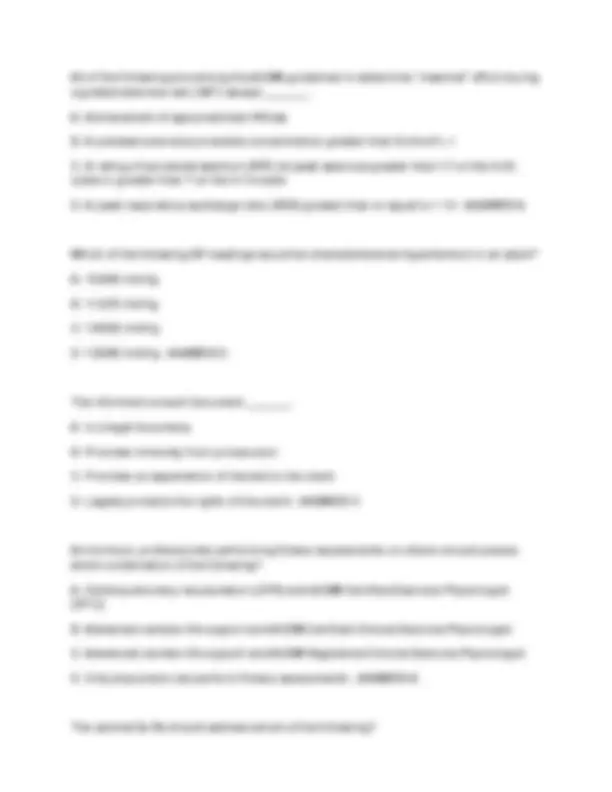
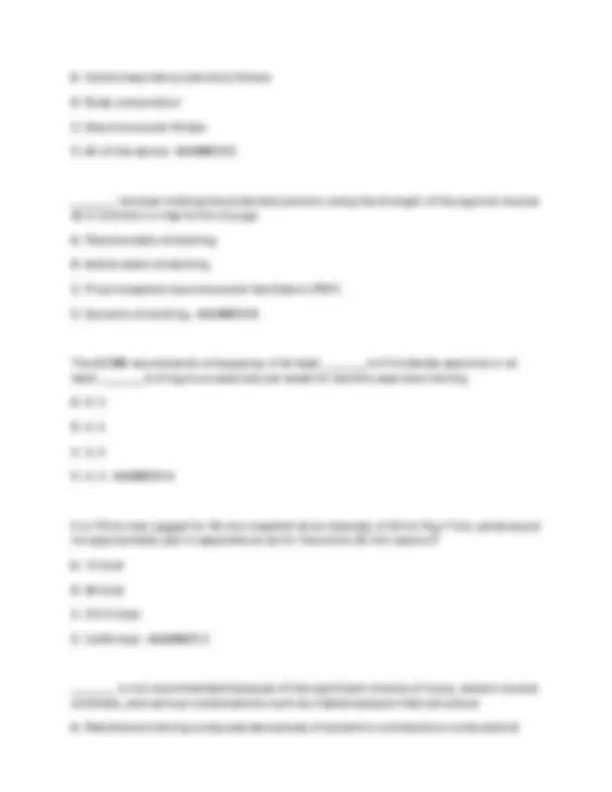
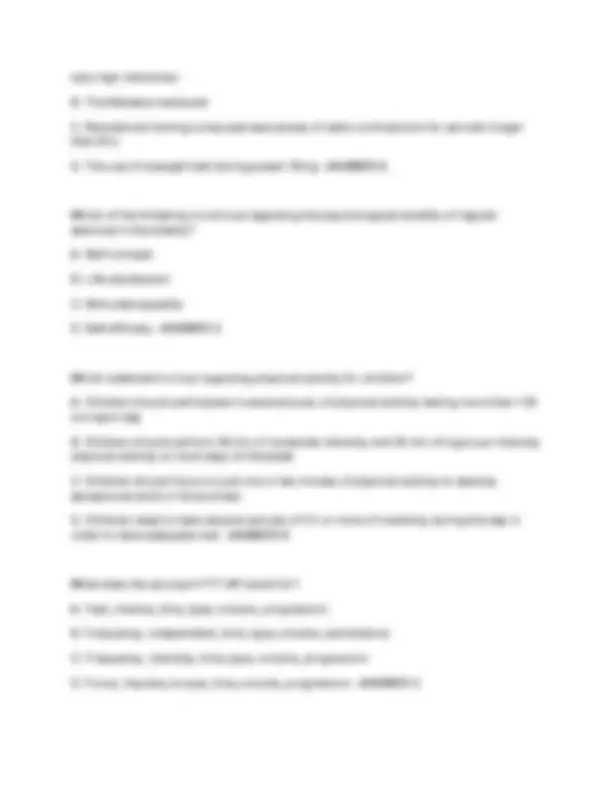
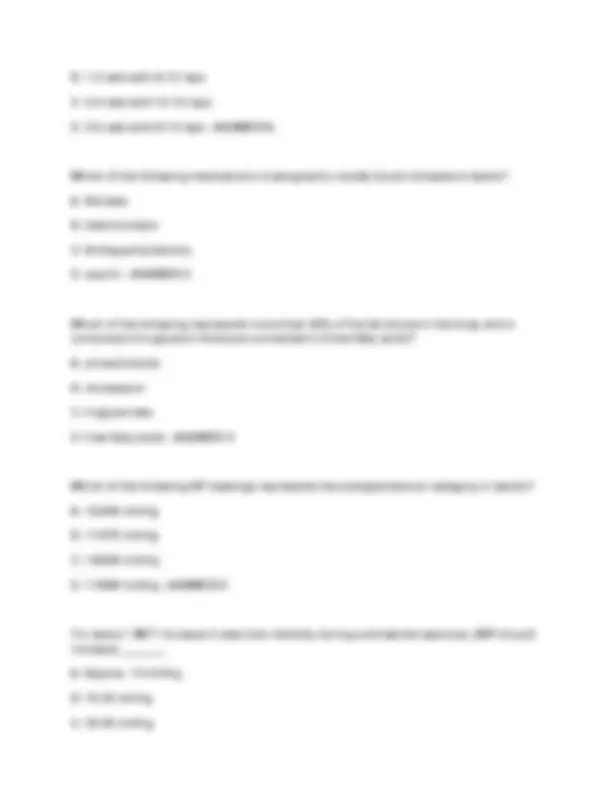
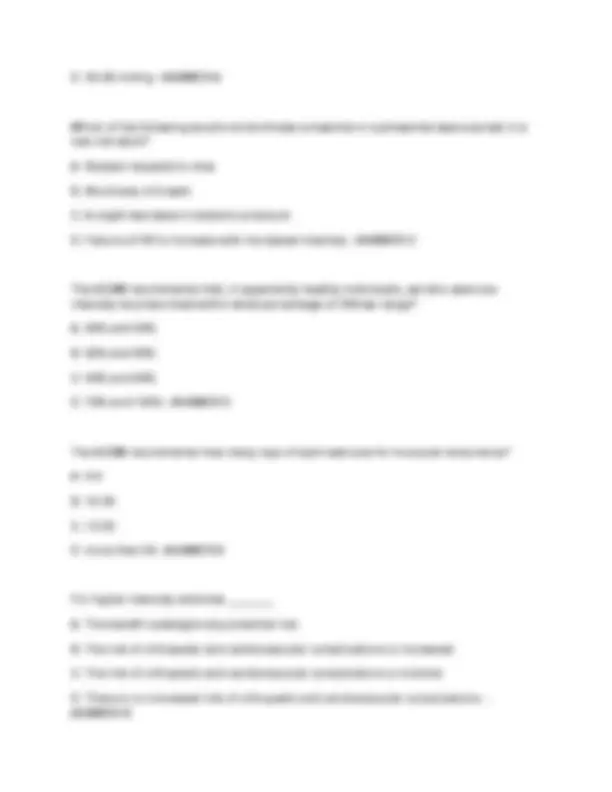
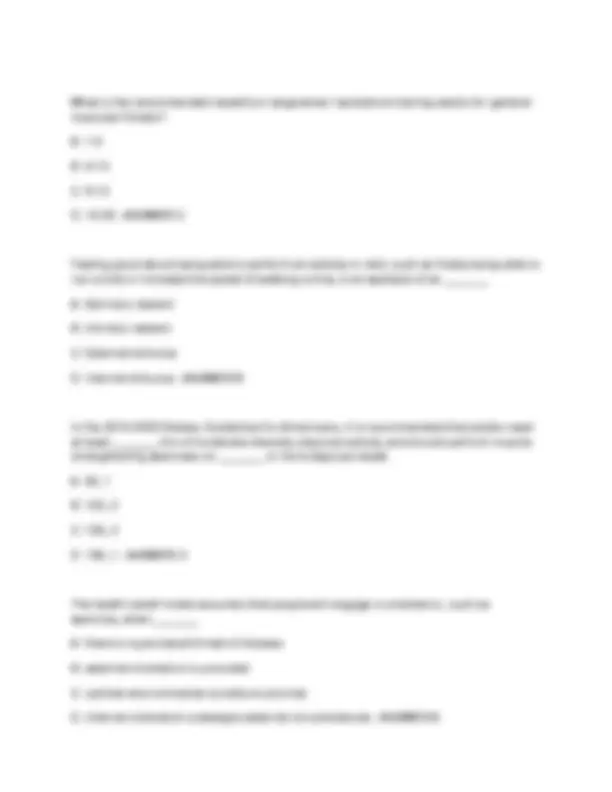
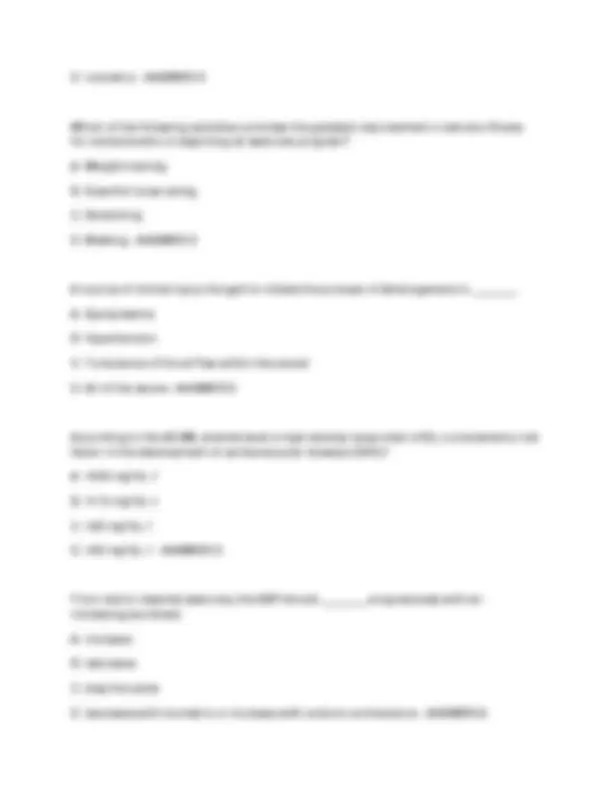
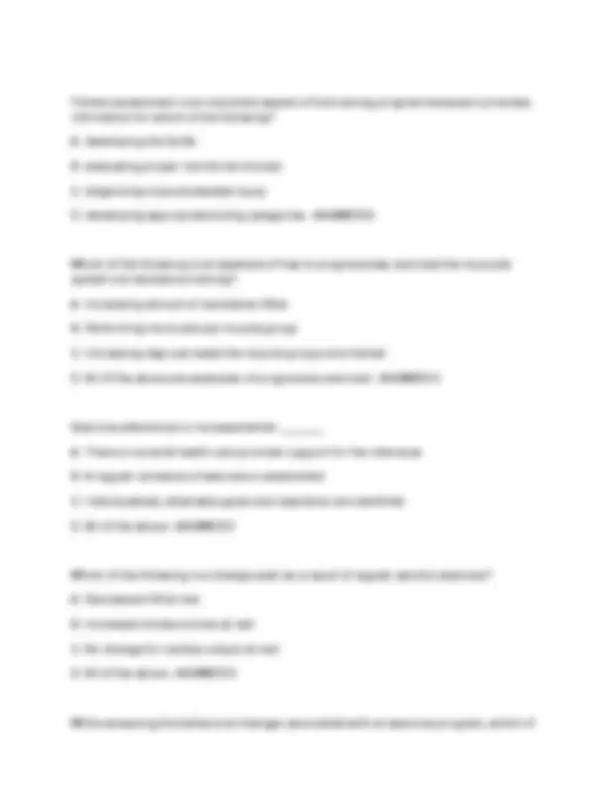
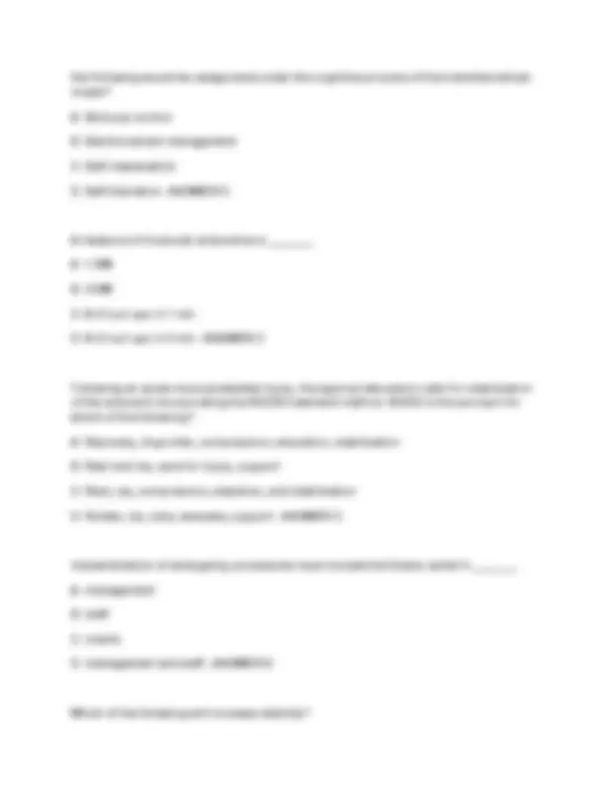
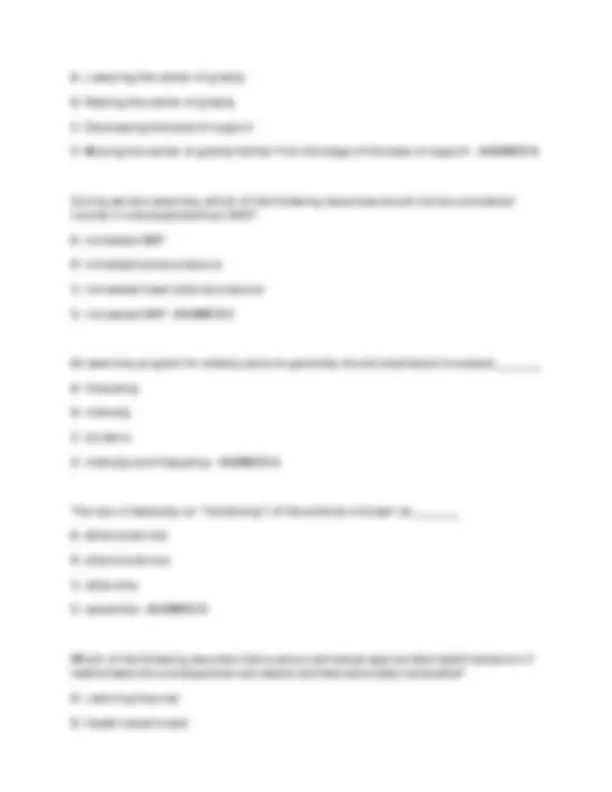
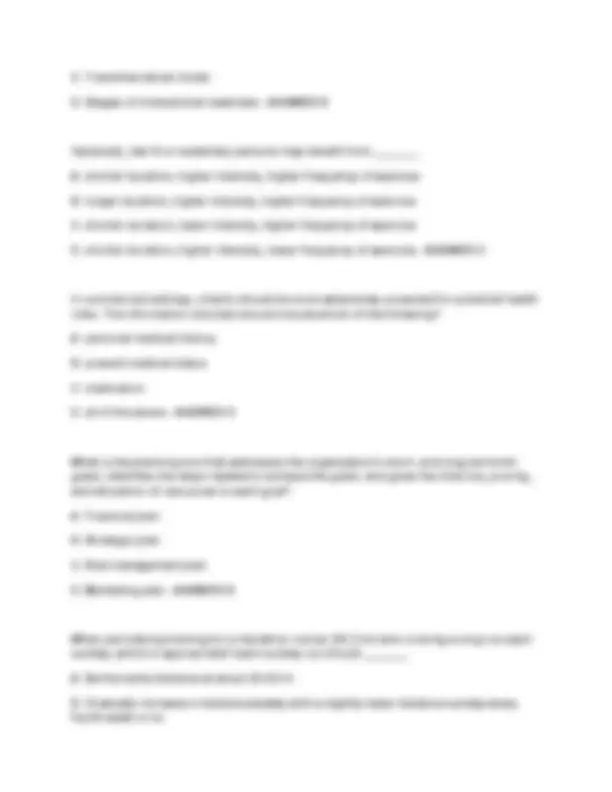
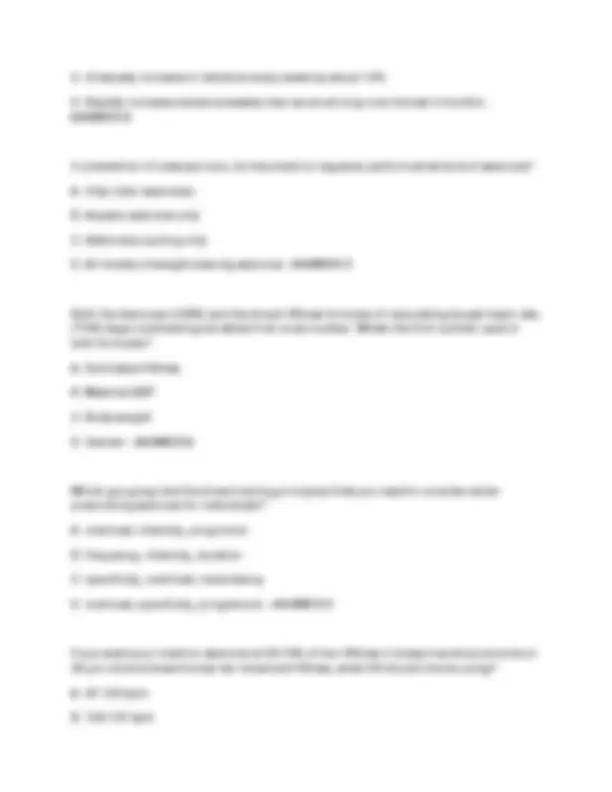
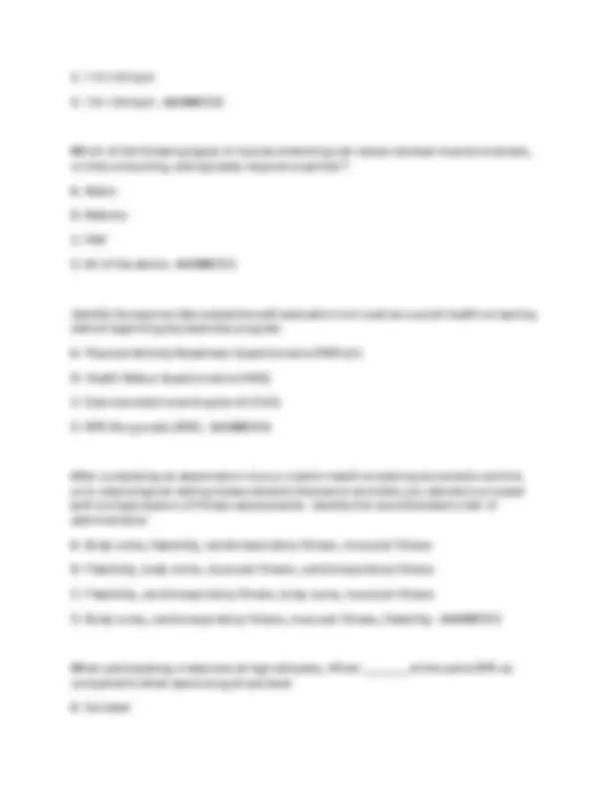
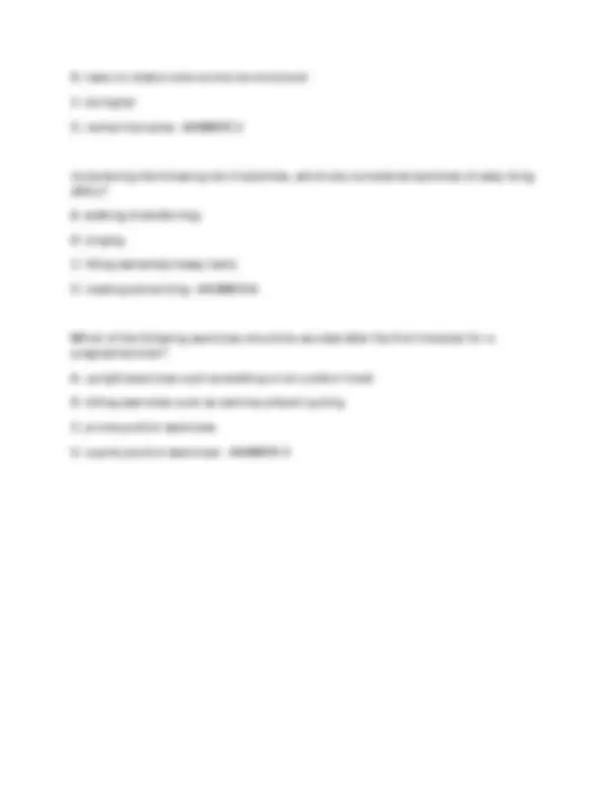


Study with the several resources on Docsity

Earn points by helping other students or get them with a premium plan


Prepare for your exams
Study with the several resources on Docsity

Earn points to download
Earn points by helping other students or get them with a premium plan
Community
Ask the community for help and clear up your study doubts
Discover the best universities in your country according to Docsity users
Free resources
Download our free guides on studying techniques, anxiety management strategies, and thesis advice from Docsity tutors
ACSM-EP PRACTICE EXAM FROM STUDY BOOK WITH 100% VERIFIED ANSWERS!!
Typology: Exams
1 / 25

This page cannot be seen from the preview
Don't miss anything!


















Underweight is classified as a body mass index (BMI) of ________? A. <19.9 kgm B. <18.5 kgm C. <24.9 kgm D. <20.5 kgm2 - ANSWER B
When measuring regional body circumstances, an average of duplicate measures is used provided that those measurements do not differ by more than ________. A. 3 mm B. 10 mm C. 5 mm D. 12 mm - ANSWER C
Which of the following represents the demarcation point of a very high health risk for young women when using waist-to-hip ratio (WHR)? A. >0. B. >0. C. >1. D. >1.03 - ANSWER A
Which of the following is accepted as the criterion measure of cardiorespiratory fitness? A. Field test performace B. Maximal volume of oxygen consumed per unit time (VO2max) C. Body fat percentage
D. Maximal heart rate (HRmax) - ANSWER B
When estimating VO2max using the YMCA cycle ergometer protocol, which of the following best describes the relationship between heart rate (HR) > 110 bpm and 85% age-predicted HRmax or 70% heart rate reserve (HRR)? A. Logarithmic B. Inverse C. Curvilinear D. Linear - ANSWER D
Which of the following variables is unique to the Rockport One-Mile Fitness Walking Test's regression equation to estimate VO2max? A. Age B. HR C. Gender D. Body mass - ANSWER C
What is the suggested work rate for a deconditioned, female individual performing the Astrand-Rhyming cycle ergometer protocol? A. 150 or 300 kgmmin-1 (25 or 50 W) B. 300 or 450 kgmmin-1 (50 or 75 W) C. 450 or 600 kgmmin-1 (75 or 100 W) D. 600 or 900 kgmmin-1 (100 or 150 W) - ANSWER B
The Queens College Step Test is performed for how long? A. 45 s B. 90 s C. 3 min D. 5 min - ANSWER C
HR, blood pressure (BP), and electrocardiogram (ECG) should be recorded regularly during the clinical exercise test and through at least ________ of recovery. A. 90 s B. 3 min C. 6 min D. 10 min - ANSWER C
The normal HR response to incremental exercise is to increase workloads at an HR of ________ per 1 metabolic equivalent (MET). A. 10 bpm B. 5 bpm C. 20 bpm D. 15 bpm - ANSWER A
The purpose of the cool-down period following an exercise session includes all of the following except ________. A. Gradual recovery HR B. Gradual recovery of BP C. Improvement in range of motion (ROM) D. Removal of metabolic end products - ANSWER C
What is the frequency of combined aerobic exercise recommended for most adults? A. 5-7 dwk- B. 4-6 dwk- C. 3-5 dwk- D. 1-3 dwk-1 - ANSWER C
Which of the following percentages of HRR would classifiy as "moderate" aerobic exercise intensity?
Which of the following methods is not recommended for estimating exercise intensity for exercise prescription (Ex Rx)? A. HRR B. Oxygen uptake reserve (VO2R) C. Ventilatory threshold (VT) D. Maximum heart rate percentage (%HRmax) - ANSWER D
What is the minimum recommended target volume for energy expenditure (EE) to promote overall health and well-being in an Ex Rx? A. 500-1,000 MET-minwk- B. 250-500 MET-MINwk- C. 150-250 MET-minwk- D. 1,000-1,500 MET-minwk-1 - ANSWER A
What is the minimum recovery time recommended for a muscle group following a resistance training bout? A. 12 h B. 24 h C. 48 h D. 72 h - ANSWER C
Which of the following is not a purpose of physical fitness testing? A. To bring in extra income to pay off other major expenses of the testing company
A. Thigh B. Medial calf C. Suprailiac D.Abdominal - ANSWER C
________ is not a contraindication of maximal exercise testing in the clinical setting. A. Acute myocarditis or pericarditis B. Ongoing unstable angina C. Recent stroke or transient ischemia attack D. Resting systolic blood pressure (SBP) between 125 & 140 mmHg or diastolic blood pressure (DBP) between 60 & 75 mmHg - ANSWER D
Clinical exercise testing among adult patients with chronic heart failure (HF) should observe the following recommendations except ________. A. Maximal exercise testing is reasonable to help determine whether HF is the cause of exercise limitation when the contribution of HF is uncertain B. Maximal exercise testing is not a realistic way to identify candidates for cardiac transplantation or other advanced treatments due to inherent risk of heart stress C. Exercise testing should be considered to detect reversible myocardial ischemia D. Exercise testing should be considered to aid in the prescription of exercise training - ANSWER B
________ pertains to the ability to correctly identify patients who do not have a given condition. A. Sensitivity B. Specificity C. Positive percent value D. Negative predictive value - ANSWER B
All of the following are among the ACSM guidelines to determine "maximal" effort during a graded exercise test (GXT) except ________. A. Achievement of age-predicted HRmax B. A postexercise venous lactate concentration greater than 8 mmol*L- C. A rating of perceived exertion (RPE) at peak exercise greater than 17 on the 6- scale or greater than 7 on the 0-10 scale D. A peak respiratory exchange ratio (RER) greater than or equal to 1.10 - ANSWER A
Which of the following BP readings would be characterized as hypertension in an adult? A. 100/60 mmHg B. 110/70 mmHg C. 140/90 mmHg D. 120/80 mmHg - ANSWER C
The informed consent document ________. A. Is a legal documeny B. Provides immunity from prosecution C. Provides an explanation of the test to the client D. Legally protects the rights of the client - ANSWER C
At minimum, professionals performing fitness assessments on others should posses which combination of the following? A. Cardiopulmonary resuscitation (CPR) and ACSM Certified Exercise Physiologist (EP-C) B. Advanced cardiac life support and ACSM Certified Clinical Exercise Physiologist C. Advanced cardiac life support and ACSM Registered Clinical Exercise Physiologist D. Only physicians can perform fitness assessments - ANSWER A
The optimal Ex Rx should address which of the following?
very high intensities B. The Valsalva maneuver C. Resistance training composed exclusively of static contractions for periods longer than 60 s D. The use of a weight belt during power lifting - ANSWER A
Which of the following is not true regarding the psychological benefits of regular exercise in the elderly? A. Self-concept B. Life satisfaction C. Stimulate appetite D. Self-efficacy - ANSWER C
Which statement is true regarding physical activity for children? A. Children should participate in several bouts of physical activity lasting more than 120 min each day B. Children should perform 30 min of moderate intensity and 30 min of vigorous intensity physical activity on most days of the week C. Children should focus on just one or two modes of physical activity to develop exceptional skills in those areas D. Children need to have several periods of 2 h or more of inactivity during the day in order to have adequate rest - ANSWER B
What does the acronym FITT-VP stand for? A. Fast, intense, time, type, volume, progression B. Frequency, independent, time, type, volume, persistence C. Frequency, intensity, time, type, volume, progression D. Force, impulse, torque, time, volume, progression - ANSWER C
Optimal Ex Rx should contain which of the following? A. Cardiorespiratory fitness, muscular strength, muscular endurance, flexibility, body compostion, and neuromuscular fitness B. Cardiorespiratory fitness, muscular power, muscular force, flexibility, body composition, and neuromuscluar fitness C. Cardiorespiratory fitness, muscular strength, muscualr force, body composition, and neuromuscular fitness D. Cardiorespiratory fitness, muscular power, muscular endurance, flexibility, and body composition - ANSWER A
According to the most recent ACSM guidelines, in order to gain health benefits, it is recommended that moderate physcial activity should be performed how many days per week? A. 2 dwk- B. 7 dwk- C. 5 dwk- D. 3 dwk-1 - ANSWER C
For health benefits, it is recommended that vigorous physical activity should be performed how many days per week? A. 2 dwk- B. 7 dwk- C. 5 dwk- D. 3 dwk-1 - ANSWER D
Moderate exercise is considered to be ________ A. 59%-79% HRR or VO2R B. 40%-59% HRR or VO2R C. 30%-45% HRR or VO2R D. 60%-89% HRR or VO2R - ANSWER B
B. 1-2 sets with 8-12 reps C. 2-4 sets with 12-15 reps D. 3-5 sets with 8-12 reps - ANSWER A
Which of the following medications is designed to modify blood cholesterol levels? A. Nitrates B. beta blockers C. Antihyperlipidemics D. aspirin - ANSWER C
Which of the following represents more than 90% of the fat stored in the body and is composed of a glycerol molecule connected to three fatty acids? A. phospholipids B. cholesterol C. triglycerides D. free fatty acids - ANSWER C
Which of the following BP readings represents the prehypertension category in adults? A. 100/60 mmHg B. 110/70 mmHg C. 160/90 mmHg D. 118/84 mmHg - ANSWER D
For every 1 MET increase in exercise intensity during submaximal exercise, SBP should increase ________ A. Approx. 10 mmHg B. 15-20 mmHg C. 25-30 mmHg
D. 30-35 mmHg - ANSWER A
Which of the following would not terminate a maximal or submaximal exercise test in a low-risk adult? A. Subject requests to stop B. Shortness of breath C. A slight decrease in diastolic pressure D. Failure of HR to increase with increased intensity - ANSWER C
The ACSM recommends that, in apparently healthy individuals, aerobic exercise intensity be prescribed within what percentage of HRmax range? A. 40% and 60% B. 50% and 80% C. 60% and 90% D. 70% and 100% - ANSWER C
The ACSM recommends how many reps of each exercise for muscular endurance? A. 5- B. 15- C. 12- D. more than 25 - ANSWER B
For higher intensity activities ________ A. The benefit outweighs any potential risk. B. The risk of orthopedic and cardiovascular complications is increased. C. The risk of orthopedic and cardiovascular complications is minimal. D. There is no increased risk of orthopedic and cardiovascular complications. - ANSWER B
If a client exercises too much without rest days or develops a minor injury and does not allow time for the injury to heal, what can occur? A. an overuse injury B. shin splints C. sleep deprivation D. decreased physical conditioning - ANSWER A
Which of the following is a false statement regarding an informed consent? A. The informed consent is not a legal document B. The informed consent does not provide legal immunity to a facility or individual in the event of injury to an individual C. Negligence, improper test administration, inadequate personnel qualifications, and insufficient safety procedures are all items that are expressly covered by the informed consent D. The consent form does not relieve the facility or individual of the responsibility to do everything possible to ensure the safety of the individual - ANSWER C
To determine program effectiveness, psychological theories provide a conceptual framework for assessment and ________ A. Management of programs or interventions B. Application of cognitive-behavioral or motivational principles C. Measurement D. All of the above - ANSWER B
An important safety consideration for exercise equipment in a fitness center includes
A. flexibility of equipment to allow for different body sizes B. affordability of equipment to allow for changing out equipment periodically C. mobility of equipment to allow for easy rearrangement
D. none of the above - ANSWER A
Which of the following personnel is responsible for overall facility management and is often responsible for assisting the development of programs? A. Administrative assistant B. Front desk staff C. Facility operator or program director D. CPT - ANSWER C
What is the purpose of agreements, releases, and consent forms? A. To inform the client of participation risks as well as the rights of the client and the facility B. To inform the client what he/she can and cannot do in the facility C. To define the relationship between facility operator & the EP-C D. To detail the rights and responsibilities of the club owner to reject an application by a prospective clinet - ANSWER A
Which of the following is a possible medical emergency that a client can experience during an exercise session? A. Hypoglycemia B. Hypotension C. Hyperglycemia D. All of the above - ANSWER D
Which of the following muscle actions occurs when muscle tension increases by the length of the muscle doesnt change? A. Concentric isotonic B. Eccentric isotonic C. Isokinetic
Fitness assessment is an important aspect of the training program because it provides information for which of the following? A. developing the Ex Rx B. evaluating proper nutritional choices C. diagnosing musculoskeletal injury D. developing appropriate billing categories - ANSWER A
Which of the following is an example of how to progressively overload the muscular system via resistance training? A. Increasing amount of resistance lifted B. Performing more sets per muscle group C. Increasing days per week the muscle groups are trained D. All of the above are examples of progressive overload - ANSWER D
Exercise adherence is increased when ________ A. There is social & health care provider support for the individual B. A regular schedule of exercise is established C. Individualized, attainable goals and objectives are identified D. All of the above - ANSWER E
Which of the following is a change seen as a result of regular aerobic exercise? A. Decreased HR at rest B. Increased stroke volume at rest C. No change for cardiac output at rest D. All of the above - ANSWER D
While assessing the behavioral changes associated with an exercise program, which of
the following would be categorized under the cognitive process of the transtheoretical model? A. Stimulus control B. Reinforcement management C. Self-reevaluation D. Self-liberation - ANSWER C
A measure of muscular endurance is ________ A. 1-RM B. 3-RM C. # of curl-ups in 1 min D. # of curl-ups in 3 min - ANSWER C
Following an acute musculoskeletal injury, the appropriate action calls for stabilization of the area and incorporating the RICES treatment method. RICES is the acronym for which of the following? A. Recovery, ibuprofen, compression, education, stabilization B. Rest and ice, care for injury, support C. Rest, ice, compression, elevation, and stabilization D. Rotate, ice, care, evaluate, support - ANSWER C
Implementation of emergency procedures must include the fitness center's ________ A. management B. staff C. clients D. management and staff - ANSWER D
Which of the following will increase stability?